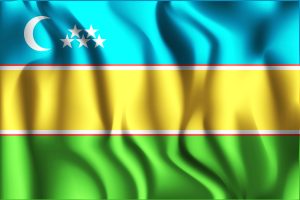On August 5, the Uzbek Supreme Court’s Telegram channel announced that three police officers — employees of the Ministry of Internal Affairs — had been “brought to criminal responsibility” for their actions during the July 2022 unrest in Karakalpakstan.
Contrary to the closely watched, and public, trials of more than 60 civilians — which concluded in January and March in Bukhara — we have little information about the three police officers in question. In February, the Uzbek Prosecutor General’s Office announced that three officers had been arrested; the officers were not named at the time. The latest announcement details that a court in Kogon City — a district-level city in Bukhara Region — had sentenced the three officers, only identified by their initials. Two (T.A. and Kh.S.) were charged with torture and given seven-year sentences, to be followed by a two-year ban on working in law enforcement after serving the sentence. The other officer (Zh.M.) was charged with perjury and, as RFE/RL phrased it, “failing to come to the rescue,” and sentenced to three years in prison and a one-year ban on working in law enforcement. The three will be able to appeal the sentences.
Many of of the civilians tried earlier this year were ultimately handed long prison terms after unusually public trials. Chris Rickleton opened an article for RFE/RL in February profiling Dauletmurat Tazhimuratov — an ethnic Karakalpak lawyer and journalist framed by Tashkent as the mastermind, and villain, behind the July 2022 protests — like this:
In previous years in Uzbekistan, a trial like the one that concluded on January 31 in the city of Bukhara would have played out behind closed doors.
These days, the government seems to prefer a spectacle.
There was no such spectacle for the law enforcement officers put on trial in a much smaller city. Unlike the civilians, there are no images (that I have seen so far) of them standing in the plexiglass cage in court.
Although some of those sentenced in January and March later had their jail terms adjusted to parole-like sentences on appeal, Tazhimuratov’s 16-year sentence stands. The charges in the two civilian trials so far ranged from organizing “mass riots” and “attempting to overthrow the constitutional order,” what Eurasianet characterized as “an array of grave public disorder charges,” to more pedestrian allegations in the second trial: “a variety of offenses ranging from vandalism and robbery to rioting and disseminating material posing a threat to the public order.”
According to Uzbek authorities, 21 people died in during the protests — four of them law enforcement. Last month, the Austria-based Freedom for Eurasia human rights group published a report claiming that at least 70 people were killed during the unrest.
In December 2022, the Uzbek Prosecutor General’s Office said that in total 171 people (ostensibly civilians) were involved as defendants in cases related to the unrest. The Prosecutor General also said that there were separate criminal cases investigating the use of weapons by law enforcement, as well as the deaths of two citizens. At the time, the Prosecutor General’s Office said that if the case went to court, the process would be open.
What’s absent, so far, from the legal maneuvering around the Karakalpakstan unrest is an explanation — and ultimately justice — for those killed. The Uzbek government made a big show in trying Tazhimuratov and the others, and also pushed through trials in absentia of two Karakalpak activists. These cases were, in my view, an effort to frame the unrest as some grand plot instead of the chaotic, but more mundane, tragedy that it was: The inevitable result of an authoritarian state coming up against an angry public.
There is a larger question still left unexplored by the government authorities: Who was killed, why, how, and by whom?































